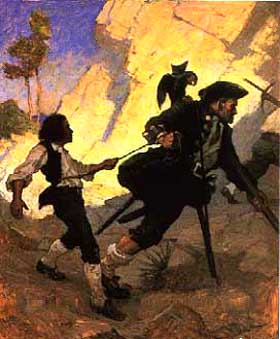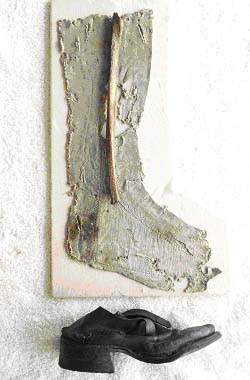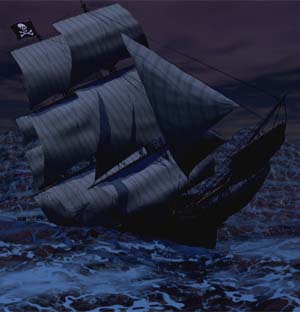pop up description layer
HOME
Cryptozoology UFO Mysteries Aviation Space & Time Dinosaurs Geology Archaeology Exploration 7 Wonders Surprising Science Troubled History Library Laboratory Attic Theater Store Index/Site Map Cyclorama
Search the Site: |
|
The Littlest Pirate In what is left of a wrecked pirate ship on the bottom of the sea near the dangerous shoals of Cape Cod, scientists have found the remains of John King, the youngest pirate ever known. Thanks to Robert Louis Stevenson, author of Treasure Island, and James Barrie, who wrote Peter Pan, countless boys have dreamed of running away from their homes to join a band of merry pirates with their adventures on the high seas. As unbelievable as it sounds today back in the 18th century such a thing was actually possible, as shown by the story of one young man named John King. The tale starts in late 1716 with a pirate named Captain "Black Sam" Bellamy. According to records, Bellamy used his sloop, the Marianne, to attack a passenger ship, the Bonetta, bound from Antigua to Jamaica. According to an Antiguan court deposition made by the Bonetta's Captain, Abijah Savage, the pirates plundered the ship for 15 days, removing all cargo of any value. During this period some of the Bonetta's crew decided that becoming a pirate looked very inviting and joined Bellamy. One was a goldsmith named Paul Williams, and another gunner's mate William Osbourne. Two other men, whose names were never recorded, also decided to try their luck with the pirates. On that same ship traveling as passengers were a boy named John King and his mother. It is difficult to say how old John was, but probably no older than eleven and possibly as young as eight. Why he and his mother were traveling is not included in the record. What is clearly documented, however, is that John wanted to be a pirate. John demanded to be allowed to join the crew of the Marianne. In fact, he he wasn't allowed to, he threatened to hurt himself according to a deposition made from the captain of the Bonetta: He further saith, that one John King who was coming as a passenger with him from the said Island of Jamaica to the Island of Antigua deserted his sloop, and went with the Pirates and was so far from being forced or compelled thereto by them as the deponent could perceive or learn that he declared he would Kill himself if he was Restrained, and even threatned his Mother who was then on Board as a Passenger with the Deponent. Life Aboard A Pirate Ship
For the members of the Bonetta's crew that decided to join Bellamy, it may have been a logical choice. On a regular ship in those days, discipline at sea would have been harsh. This, combined with bad food and poor pay, left many sailors discontent. Almost all pirate ships, in contrast, were run as small democracies with the crews drawing up a set of rules for themselves to live by and sharing the booty they could take. They often even elected their own captains. While most pirates never got rich and many died young, many sailors still found it a better choice than life under a cruel navy or merchant captain. It isn't clear why young John was so keen to become a buccaneer. As a passenger he wouldn't have been affected by discipline practices on the Bonetta. We can only speculate that perhaps he was traveling to a place he didn't want to go. Perhaps he was in the company of a harsh parent or stepparent. In any case, we do know that Bellamy did eventually let him join his crew. Teenage pirates were common, and the British Navy also employed young boys as "powder monkeys" to move gunpowder from the ship's magazine to the cannons, but nowhere else in the historical record was there a child so young allowed to join a ban of buccaneers. Why did Bellamy permit it? Ken Kinkor, a historian at the Expedition Whydah Sea-Lab and Learning Center, speculates "I tend to think that from what we know of Bellamy he was kind of a charismatic individual. I think Bellamy may have admired the kid's spirit. This kid, I can almost see him begging Bellamy to let him join and Bellamy not having the heart to refuse." King did join Bellamy's crew and was apparently with them as they raided a number of ships in the Caribbean over the next few months. In February of 1717, between the islands of Cuba and Haiti, the Marianne ran into the Whydah, a heavily armed 100-foot long slave galley. Bellamy captured it and decided to make it his new flag ship. The Wreck of the Whydah The fate of John King after he joined Bellamy's crew might never have been known had it not been for the tenacious efforts of treasure hunter Barry Clifford. As a boy, Clifford had heard local legends around Cape Cod about a pirate ship that had sunk off the coast in the 18th century. Clifford carefully researched possible locations of the ship and, aided by a 1717 map, set out to use electronic devices to look for the remains. His search commenced in late 1982 but it wasn't until 1984 that he found cannon, silver "pieces-of-eight" and other artifacts. The ship Clifford found was Bellamy's Whydah which had sunk during a fierce storm on April 26, 1717. Today, with Blackbeard's ship, Queen Anne's Revenge, it remains the only confirmed wreck of a pirate ship that has been excavated.
Although the Whydah did not carry the amounts of treasure Clifford might have hoped for, it did provide almost 200,000 artifacts that helped tell the story of life aboard an 18th century pirate ship. The mass of artifacts collected over the next several decades included a lump (or as scientists like to call it a "concretion") of material brought up from the bottom in 1989 which contained the remains of a human fibula (leg bone), a stocking and a small shoe. At the time, assuming the objects belonged to a tiny adult, Clifford thought "My God, these people were small back thenů" and put the items in storage where they stayed for a number of years. Only in 2006 did Kinkor persuade Clifford to have the bone examined by researchers at The Center for Historical Archaeology in Florida and the Smithsonian Institute. Their results indicated that the bone belonged to a child between eight and eleven years of age. Immediately the historians connected the find with the story of John King, revealing his fate. King apparently went with Bellamy when he transferred his command to the Whydah. They took the 18-gun ship up the coast of the United States, raiding vessels along the way. According to legend, Bellamy was on his way to visit a sweetheart when the ship was caught in a heavy storm. The ship sank and only two out of the crew of 146 survived to tell the tale. The remains of the littlest pirate, bone, sock and shoe, now are part of the collection at the Whydah Center in Provincetown, Massachusetts. There they sit as a reminder of the days when even little boys could become fierce pirates. Copyright Lee Krystek 2006. All Rights Reserved. |
|
Related Links |
|
|






